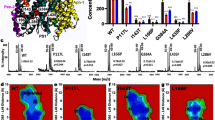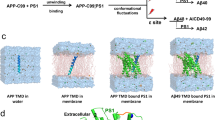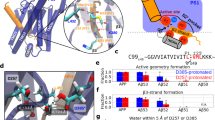Abstract
The γ-secretase complex, comprising presenilin 1 (PS1), PEN-2, APH-1 and nicastrin, is a membrane-embedded protease that controls a number of important cellular functions through substrate cleavage. Aberrant cleavage of the amyloid precursor protein (APP) results in aggregation of amyloid-β, which accumulates in the brain and consequently causes Alzheimer’s disease. Here we report the three-dimensional structure of an intact human γ-secretase complex at 4.5 Å resolution, determined by cryo-electron-microscopy single-particle analysis. The γ-secretase complex comprises a horseshoe-shaped transmembrane domain, which contains 19 transmembrane segments (TMs), and a large extracellular domain (ECD) from nicastrin, which sits immediately above the hollow space formed by the TM horseshoe. Intriguingly, nicastrin ECD is structurally similar to a large family of peptidases exemplified by the glutamate carboxypeptidase PSMA. This structure serves as an important basis for understanding the functional mechanisms of the γ-secretase complex.
This is a preview of subscription content, access via your institution
Access options
Subscribe to this journal
Receive 51 print issues and online access
$199.00 per year
only $3.90 per issue
Buy this article
- Purchase on Springer Link
- Instant access to full article PDF
Prices may be subject to local taxes which are calculated during checkout



Similar content being viewed by others
Accession codes
Primary accessions
Electron Microscopy Data Bank
Protein Data Bank
Data deposits
The modelled atomic coordinates of nicastrin has been deposited in the Protein Data Bank with the accession code 4UPC. In addition, the 4.5 Å and 5.4 Å EM maps have been deposited in EMDB with accession codes EMD-2677 and EMD-2678, respectively.
References
Selkoe, D. J. & Wolfe, M. S. Presenilin: running with scissors in the membrane. Cell 131, 215–221 (2007)
De Strooper, B., Iwatsubo, T. & Wolfe, M. S. Presenilins and γ-secretase: structure, function, and role in Alzheimer disease. Cold Spring Harb. Persp. Medi. 2, a006304 (2012)
Brown, M. S., Ye, J., Rawson, R. B. & Goldstein, J. L. Regulated intramembrane proteolysis: a control mechanism conserved from bacteria to humans. Cell 100, 391–398 (2000)
Wolfe, M. S. Toward the structure of presenilin/γ-secretase and presenilin homologs. Biochim. Biophys. Acta 1828, 2886–2897 (2013)
De Strooper, B. Aph-1, Pen-2, and Nicastrin with Presenilin generate an active γ-secretase complex. Neuron 38, 9–12 (2003)
Kimberly, W. T. et al. γ-secretase is a membrane protein complex comprised of presenilin, nicastrin, Aph-1, and Pen-2. Proc. Natl Acad. Sci. USA 100, 6382–6387 (2003)
Schedin-Weiss, S., Winblad, B. & Tjernberg, L. O. The role of protein glycosylation in Alzheimer disease. FEBS J. 281, 46–62 (2014)
Wolfe, M. S. et al. Two transmembrane aspartates in presenilin-1 required for presenilin endoproteolysis and γ-secretase activity. Nature 398, 513–517 (1999)
De Strooper, B. et al. Deficiency of presenilin-1 inhibits the normal cleavage of amyloid precursor protein. Nature 391, 387–390 (1998)
De Strooper, B. et al. A presenilin-1-dependent γ-secretase-like protease mediates release of Notch intracellular domain. Nature 398, 518–522 (1999)
Struhl, G. & Greenwald, I. Presenilin is required for activity and nuclear access of Notch in Drosophila. Nature 398, 522–525 (1999)
Thinakaran, G. et al. Endoproteolysis of presenilin 1 and accumulation of processed derivatives in vivo. Neuron 17, 181–190 (1996)
Takasugi, N. et al. The role of presenilin cofactors in the γ-secretase complex. Nature 422, 438–441 (2003)
Gu, Y. et al. APH-1 interacts with mature and immature forms of presenilins and nicastrin and may play a role in maturation of presenilin·nicastrin complexes. J. Biol. Chem. 278, 7374–7380 (2003)
LaVoie, M. J. et al. Assembly of the γ-secretase complex involves early formation of an intermediate subcomplex of Aph-1 and nicastrin. J. Biol. Chem. 278, 37213–37222 (2003)
Steiner, H., Winkler, E. & Haass, C. Chemical cross-linking provides a model of the γ-secretase complex subunit architecture and evidence for close proximity of the C-terminal fragment of presenilin with APH-1. J. Biol. Chem. 283, 34677–34686 (2008)
Kaether, C. et al. The presenilin C-terminus is required for ER-retention, nicastrin-binding and γ-secretase activity. EMBO J. 23, 4738–4748 (2004)
Shah, S. et al. Nicastrin functions as a γ-secretase-substrate receptor. Cell 122, 435–447 (2005)
Dries, D. R. et al. Glu-333 of nicastrin directly participates in γ-secretase activity. J. Biol. Chem. 284, 29714–29724 (2009)
Lazarov, V. K. et al. Electron microscopic structure of purified, active γ-secretase reveals an aqueous intramembrane chamber and two pores. Proc. Natl Acad. Sci. USA 103, 6889–6894 (2006)
Ogura, T. et al. Three-dimensional structure of the γ-secretase complex. Biochem. Biophys. Res. Commun. 343, 525–534 (2006); corrigendum. 345, 543 (2006)
Osenkowski, P. et al. Cryoelectron microscopy structure of purified γ-secretase at 12 Å resolution. J. Mol. Biol. 385, 642–652 (2009)
Renzi, F. et al. Structure of γ-secretase and its trimeric pre-activation intermediate by single-particle electron microscopy. J. Biol. Chem. 286, 21440–21449 (2011)
Li, Y. et al. Structural interactions between inhibitor and substrate docking sites give insight into mechanisms of human PS1 complexes. Structure 22, 125–135 (2014)
Sobhanifar, S. et al. Structural investigation of the C-terminal catalytic fragment of presenilin 1. Proc. Natl Acad. Sci. USA 107, 9644–9649 (2010)
Li, X. et al. Structure of a presenilin family intramembrane aspartate protease. Nature 493, 56–61 (2013)
Bai, X. C., Fernandez, I. S., McMullan, G. & Scheres, S. H. Ribosome structures to near-atomic resolution from thirty thousand cryo-EM particles. eLife 2, e00461 (2013)
Li, X. et al. Electron counting and beam-induced motion correction enable near-atomic-resolution single-particle cryo-EM. Nature Methods 10, 584–590 (2013)
Amunts, A. et al. Structure of the yeast mitochondrial large ribosomal subunit. Science 343, 1485–1489 (2014)
Allegretti, M., Mills, D. J., McMullan, G., Kuhlbrandt, W. & Vonck, J. Atomic model of the F420-reducing [NiFe] hydrogenase by electron cryo-microscopy using a direct electron detector. eLife 3, e01963 (2014)
Liao, M., Cao, E., Julius, D. & Cheng, Y. Structure of the TRPV1 ion channel determined by electron cryo-microscopy. Nature 504, 107–112 (2013)
Serneels, L. et al. Differential contribution of the three Aph1 genes to γ-secretase activity in vivo. Proc. Natl Acad. Sci. USA 102, 1719–1724 (2005)
Tang, Y. P. & Gershon, E. S. Genetic studies in Alzheimer's disease. Dialogues Clin. Neurosci. 5, 17–26 (2003)
Li, Y. M. et al. Presenilin 1 is linked with γ-secretase activity in the detergent solubilized state. Proc. Natl Acad. Sci. USA 97, 6138–6143 (2000)
Kornilova, A. Y., Das, C. & Wolfe, M. S. Differential effects of inhibitors on the γ-secretase complex. Mechanistic implications. J. Biol. Chem. 278, 16470–16473 (2003)
Scheres, S. H. RELION: implementation of a Bayesian approach to cryo-EM structure determination. J. Struct. Biol. 180, 519–530 (2012)
Rosenthal, P. B. & Henderson, R. Optimal determination of particle orientation, absolute hand, and contrast loss in single-particle electron cryomicroscopy. J. Mol. Biol. 333, 721–745 (2003)
Fagan, R., Swindells, M., Overington, J. & Weir, M. Nicastrin, a presenilin-interacting protein, contains an aminopeptidase/transferrin receptor superfamily domain. Trends Biochem. Sci. 26, 213–214 (2001)
Zhang, A. X. et al. A remote arene-binding site on prostate specific membrane antigen revealed by antibody-recruiting small molecules. J. Am. Chem. Soc. 132, 12711–12716 (2010)
Bammens, L., Chavez-Gutierrez, L., Tolia, A., Zwijsen, A. & De Strooper, B. Functional and topological analysis of Pen-2, the fourth subunit of the γ-secretase complex. J. Biol. Chem. 286, 12271–12282 (2011)
Watanabe, N. et al. Pen-2 is incorporated into the γ-secretase complex through binding to transmembrane domain 4 of presenilin 1. J. Biol. Chem. 280, 41967–41975 (2005)
Kim, S. H. & Sisodia, S. S. Evidence that the “NF” motif in transmembrane domain 4 of presenilin 1 is critical for binding with PEN-2. J. Biol. Chem. 280, 41953–41966 (2005)
Althoff, T., Mills, D. J., Popot, J. L. & Kuhlbrandt, W. Arrangement of electron transport chain components in bovine mitochondrial supercomplex I1III2IV1. EMBO J. 30, 4652–4664 (2011)
Tribet, C., Audebert, R. & Popot, J. L. Amphipols: polymers that keep membrane proteins soluble in aqueous solutions. Proc. Natl Acad. Sci. USA 93, 15047–15050 (1996)
Wang, Y., Zhang, Y. & Ha, Y. Crystal structure of a rhomboid family intramembrane protease. Nature 444, 179–180 (2006). Published online 2006 Oct 11
Wu, Z. et al. Structural analysis of a rhomboid family intramembrane protease reveals a gating mechanism for substrate entry. Nature Struct. Mol. Biol. 13, 1084–1091 (2006)
Ben-Shem, A., Fass, D. & Bibi, E. Structural basis for intramembrane proteolysis by rhomboid serine proteases. Proc. Natl Acad. Sci. USA 104, 462–466 (2007)
Feng, L. et al. Structure of a site-2 protease family intramembrane metalloprotease. Science 318, 1608–1612 (2007)
DeLano, W. L. The PyMOL Molecular Graphics System http://www.pymol.org (2002)
Pettersen, E. F. et al. UCSF Chimera—a visualization system for exploratory research and analysis. J. Comput. Chem. 25, 1605–1612 (2004)
Matsuda, T. & Cepko, C. L. Electroporation and RNA interference in the rodent retina in vivo and in vitro. Proc. Natl Acad. Sci. USA 101, 16–22 (2004)
Alexandrov, A. et al. A facile method for high-throughput co-expression of protein pairs. Mol. Cell. Proteomics 3, 934–938 (2004)
Scheich, C., Kummel, D., Soumailakakis, D., Heinemann, U. & Bussow, K. Vectors for co-expression of an unrestricted number of proteins. Nucleic Acids Res. 35, e43 (2007)
Mindell, J. A. & Grigorieff, N. Accurate determination of local defocus and specimen tilt in electron microscopy. J. Struct. Biol. 142, 334–347 (2003)
Elmlund, H., Elmlund, D. & Bengio, S. PRIME: probabilistic initial 3D model generation for single-particle cryo-electron microscopy. Structure 21, 1299–1306 (2013)
Chen, S. et al. High-resolution noise substitution to measure overfitting and validate resolution in 3D structure determination by single particle electron cryomicroscopy. Ultramicroscopy 135, 24–35 (2013)
Kucukelbir, A., Sigworth, F. J. & Tagare, H. D. Quantifying the local resolution of cryo-EM density maps. Nature Methods 11, 63–65 (2014)
Emsley, P. & Cowtan, K. Coot: model-building tools for molecular graphics. Acta Crystallogr. D Biol. Crystallogr. 60, 2126–2132 (2004)
Murshudov, G. N. et al. REFMAC5 for the refinement of macromolecular crystal structures. Acta Crystallogr. D Biol. Crystallogr. 67, 355–367 (2011)
Nicholls, R. A., Long, F. & Murshudov, G. N. Low-resolution refinement tools in REFMAC5. Acta Crystallogr. D Biol. Crystallogr. 68, 404–417 (2012)
Acknowledgements
We thank M. Wolfe and D. Selkoe for support and encouragement, and S. Chen, C. Savva, J. Grimmett and T. Darling for technical support. This work was funded by the Ministry of Science and Technology of China (2009CB918801 to Y.S.), National Natural Science Foundation of China (projects 30888001, 31021002 and 31130002 to Y.S.), a European Union Marie Curie Fellowship (to X.C.B.), and the UK Medical Research Council (MC_UP_A025_1013, to S.H.W.S.).
Author information
Authors and Affiliations
Contributions
P.L., X.B., D.M., S.H.W.S. and Y.S. designed all experiments. P.L., X.B., D.M., T.X., C.Y., L.S., G.Y., Y.Z. and R.Z. performed the experiments. All authors contributed to data analysis. P.L., X.B., D.M., S.H.W.S. and Y.S. contributed to manuscript preparation.
Corresponding authors
Ethics declarations
Competing interests
The authors declare no competing financial interests.
Extended data figures and tables
Extended Data Figure 1 Construction of the pMLink vector for co-expression of the four components of γ-secretase.
a, A schematic diagram of the empty pMLink plasmid. The empty pMLink plasmid was created by insertion of the LINK1 and LINK2 sequences52,53 into the pCAG vector51. The two LINK sequences allow insertion of a PacI digested fragment from one plasmid at the SwaI site of a second plasmid by ligation-independent cloning (LIC) method52,53. The four components of γ-secretase were individually cloned into the multiple cloning sites of the empty pMLink vector, generating four plasmids. b, Construction of the pMLink vector that contains all four components of γ-secretase. First, pMLink-PEN-2 and pMLink-nicastrin were combined by the LIC method to generate pMLink-PEN-2-nicastrin, whereas pMLink-APH-1 and pMLink-PS1 gave rise to pMLink-APH-1-PS1. Then, the two plasmids pMLink-PEN-2-nicastrin and pMLink-APH-1-PS1 were combined to generate the final plasmid pMLink-PEN-2-nicastrin-APH-1-PS1. EC, expression cassette (containing promoter, target gene and poly-A sequence). c, Expression of PS1 alone resulted in the production of the uncleaved PS1 protein. Transfection of pMLink-PS1 into HEK293F cells led to expression of the uncleaved, full-length PS1. Shown here is result of a western blot analysis using a monoclonal antibody against the NTF of PS1. d, The purified γ-secretase in amphipol A8-35 was proteolytically active against the APP substrate C100. Cleavage of the substrate APP-C100 was blocked by the specific inhibitor III-31C. The same γ-secretase in amphipol A8-35 under the same buffer was used for cryo-EM analysis.
Extended Data Figure 2 Cryo-EM analysis of the human γ-secretase complex.
a, Analysis of γ-secretase in digitonin imaged on back-thinned Falcon II. A representative electron micrograph (scale bar, 20 nm) and reference-free two-dimensional class averages are shown in the top and bottom panels, respectively. b, Analysis of γ-secretase in amphipols imaged on back-thinned Falcon II. c, Analysis of γ-secretase in amphipols imaged on K2 Summit. d, Comparison of densities for the three methods of imaging described above. The fewest number of particles (37,310) was used for the generation of higher-resolution images for samples in amphipols on the K2 Summit.
Extended Data Figure 3 Density and resolution of the human γ-secretase complex.
a, Resolution limit (colour-coded) of the cryo-EM density for γ-secretase in amphipols imaged on K2 Summit. The left panel shows a cut-through view of the interior of the maps. The middle panel shows the entire maps. The low-resolution density (purple colour) is likely to represent the density from amphipols. The right panel shows the best density for TMs in the map, with some of the side-chain features visible. The 4.5-Å EM map was used here. b, Gold-standard FSC curves for the density maps. The resolution limits reached 4.5 Å and 5.4 Å, respectively, after one (red) or two (green) steps of three-dimensional classification. c, The FSC curve between the nicastrin ECD atomic model and the corresponding part of the cryo-EM map.
Extended Data Figure 4 Tilt-pair validation of the correct handedness of γ-secretase.
Tilt-pair validation plots are shown for γ-secretase and 80S ribosome imaged on the same electron microscope at 0° and 20° tilt angles, under the same magnification, and using the same detector. The position of each dot represents the direction and the amount of tilting for a particle pair in polar coordinates. Blue dots correspond to in-plane tilt transformations; red dots correspond to out-of-plane tilt transformations. For both samples blue dots cluster in the same region of the plot at a tilt angle of approximately 20°, which validates the structure and confirms that our γ-secretase map is in the same handedness as the 80S ribosome map. Note that the increased scatter of the points in the γ-secretase plot results from the significantly smaller molecular weight compared to the 80S ribosome, which results in much less accurate orientational assignments.
Extended Data Figure 5 Connecting density of the TMs.
Seven pairs of TMs are shown for which there is electron-microscopy density connecting the two TMs. The orientation of these seven pairs of TMs reflects that in the intact γ-secretase complex, with extracellular space on the upper side and cytoplasm on the lower side. The 5.4-Å density map was used here. This figure was prepared using Chimera50.
Extended Data Figure 6 The density map for the ECD of nicastrin in stereo view.
The electron-microscopy density is shown in cyan, whereas the built model is displayed in Cα trace. The 4.5-Å density map was used here. This figure was prepared using PyMol49.
Extended Data Figure 7 Sequence alignment between nicastrin ECD and the glutamate carboxyl peptidase PSMA.
Identical amino acids between nicastrin and PSMA are highlighted in red, and conserved residues are shown in blue. PSMA39 residues that coordinate the first and second zinc atoms are identified by red squares and red circles, respectively (above the sequences). Residues in nicastrin that are aligned to the proximity of zinc-binding sites in PSMA are indicated by blue triangles.
Extended Data Figure 8 Speculative assignment of TMs and implications for γ-secretase function.
a, TMs 1–11 are putatively assigned to PS1 (blue) and PEN-2 (purple). This assignment is based on three assumptions: first, PS1 is structurally homologous to mmPSH26 that contains three layers of TMs; second, all TMs in the intact γ-secretase have been identified in the current electron-microscopy structure; and third, PS1 does not undergo drastic structural rearrangement upon binding to the other three components. Two perpendicular views and a cut-through section are shown. For ease of discussion, we numbered the 19 TMs arbitrarily. b, Structural comparison of PS1 (blue) with its archaeal homologue mmPSH (grey). PS1 and mmPSH share 23 per cent sequence identity in the TM region. Structure of mmPSH represents the inactive conformation26. In this speculative comparison, the two TMs of PEN-2 are inserted between TM7 and TM8 of PS1, possibly triggering marked conformational shifts in nearby TMs. c, A contrasting model of TM assignment in γ-secretase. Although less likely, we cannot rule out the possibility that PS1 is located at the thin end of the TM horseshoe. In this case, APH-1 would be assigned to the thick end.
Rights and permissions
About this article
Cite this article
Lu, P., Bai, Xc., Ma, D. et al. Three-dimensional structure of human γ-secretase. Nature 512, 166–170 (2014). https://doi.org/10.1038/nature13567
Received:
Accepted:
Published:
Issue Date:
DOI: https://doi.org/10.1038/nature13567
This article is cited by
-
The role of Hedgehog and Notch signaling pathway in cancer
Molecular Biomedicine (2022)
-
Molecular basis for isoform-selective inhibition of presenilin-1 by MRK-560
Nature Communications (2022)
-
Role of cholesterol in substrate recognition by \(\gamma\)-secretase
Scientific Reports (2021)
-
Targeting Notch in oncology: the path forward
Nature Reviews Drug Discovery (2021)
-
Substrate-based chemical probes for Alzheimer’s γ-secretase
Medicinal Chemistry Research (2020)
Comments
By submitting a comment you agree to abide by our Terms and Community Guidelines. If you find something abusive or that does not comply with our terms or guidelines please flag it as inappropriate.



